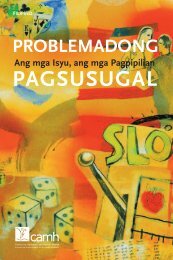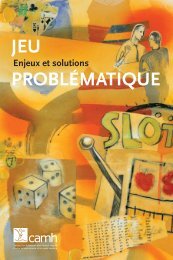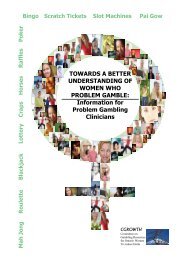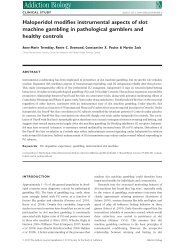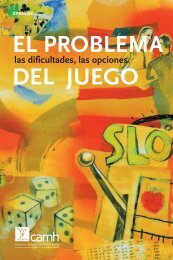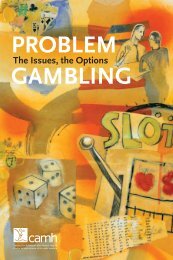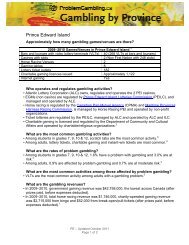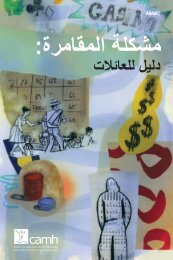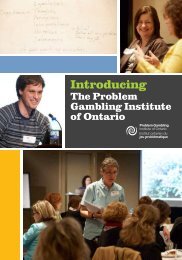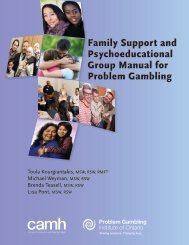Probability, Random Events, and the Mathematics of Gambling
Probability, Random Events, and the Mathematics of Gambling
Probability, Random Events, and the Mathematics of Gambling
Create successful ePaper yourself
Turn your PDF publications into a flip-book with our unique Google optimized e-Paper software.
oard games we have looked at are not perfectly square <strong>and</strong> <strong>the</strong>refore have o<strong>the</strong>r biases.<br />
However, casino dice have flat sides with no holes, are manufactured to ensure that <strong>the</strong>y are<br />
square <strong>and</strong> are tested for balance regularly by <strong>the</strong> casino. The bias in home dice may be <strong>the</strong><br />
source <strong>of</strong> <strong>the</strong> belief that energetic rolling leads to large numbers, because a bias will show up<br />
more <strong>of</strong>ten when a lot <strong>of</strong> energy is put into <strong>the</strong> roll.<br />
Bingo <strong>and</strong> Lotteries<br />
To ensure r<strong>and</strong>omness in bingo <strong>and</strong> lottery balls, <strong>the</strong> balls are kept in an enclosed space <strong>and</strong><br />
moved around by air or <strong>the</strong> rolling <strong>of</strong> <strong>the</strong> cages. Additional bounce may be achieved using a<br />
spring at <strong>the</strong> bottom <strong>of</strong> <strong>the</strong> bingo cage. The cage may be made <strong>of</strong> plastic or wire; <strong>the</strong> nature <strong>of</strong><br />
<strong>the</strong> cage ensures additional variation, adding to <strong>the</strong> r<strong>and</strong>omness. The numbers on bingo balls<br />
are embedded into <strong>the</strong> ball so that <strong>the</strong>re is no differential weight or drag that would make one<br />
ball more likely to be selected than ano<strong>the</strong>r. While <strong>the</strong> balls might be entered in <strong>the</strong> same<br />
order, r<strong>and</strong>omness is ensured by tiny differences in <strong>the</strong> initial position <strong>of</strong> <strong>the</strong> balls, <strong>the</strong> air<br />
pressure, dust or smoke in <strong>the</strong> air, humidity, <strong>and</strong> <strong>the</strong> timing <strong>of</strong> <strong>the</strong> removal <strong>of</strong> <strong>the</strong> balls.<br />
Fur<strong>the</strong>rmore, <strong>the</strong> introduction <strong>of</strong> turbulence through <strong>the</strong> air jet or rolling adds a great deal <strong>of</strong><br />
complexity.<br />
Cards<br />
Cards are perhaps <strong>the</strong> least efficient r<strong>and</strong>omizer currently available. <strong>R<strong>and</strong>om</strong>izing cards is a<br />
two-step process including shuffling, which mixes up <strong>the</strong> cards (complexity), <strong>and</strong> cutting <strong>the</strong><br />
deck, which ensures uncertainty about how <strong>the</strong> decks are mixed toge<strong>the</strong>r. Washing <strong>the</strong> deck<br />
(spreading <strong>the</strong>m out face down <strong>and</strong> mixing <strong>the</strong>m around <strong>the</strong> table) is also used to increase <strong>the</strong><br />
r<strong>and</strong>omness <strong>of</strong> <strong>the</strong> cards. With most types <strong>of</strong> r<strong>and</strong>omizers, past results cannot affect <strong>the</strong><br />
outcome <strong>of</strong> <strong>the</strong> next draw. However, because cards are drawn from a limited pack, each card<br />
draw influences <strong>the</strong> probability <strong>of</strong> <strong>the</strong> next card. If, for example, 3 aces out <strong>of</strong> 4 have already<br />
been drawn, <strong>the</strong> chance that <strong>the</strong> next card will be an ace is very small. Consequently a skilled<br />
blackjack player can make money by card counting (Thorpe, 1966). Most people have some<br />
experience <strong>of</strong> playing cards at home, <strong>and</strong> this card-playing experience is perhaps a source <strong>of</strong><br />
<strong>the</strong> very common belief that r<strong>and</strong>om events correct <strong>the</strong>mselves because, with a deck <strong>of</strong> cards,<br />
to some extent <strong>the</strong>y do.<br />
It takes about seven complete shuffles to ensure r<strong>and</strong>omness (Patterson, 1990), but given that<br />
games such as blackjack <strong>and</strong> baccarat <strong>of</strong>ten use six or more decks at a time, most casinos do<br />
not have enough time to completely r<strong>and</strong>omize <strong>the</strong>ir decks. This has given rise to a system<br />
called “shuffle tracking,” which is a variant on card counting (Patterson, 1990). Recent<br />
advances in computer technology have led to <strong>the</strong> creation <strong>of</strong> automatic shufflers, which use a<br />
r<strong>and</strong>om number generator to determine how to cut <strong>and</strong> sort <strong>the</strong> deck. In one variation, after<br />
16




